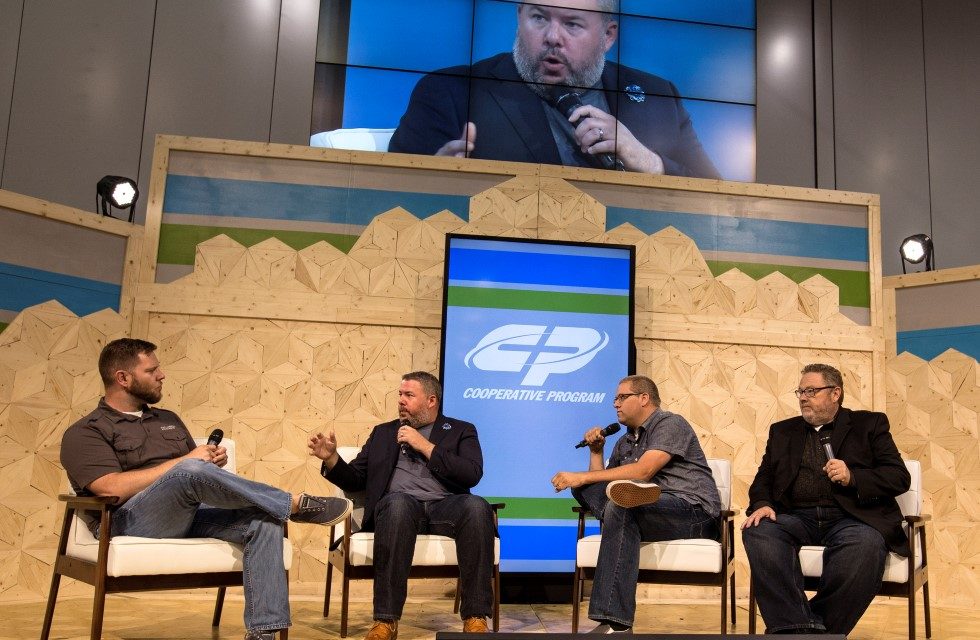Brian Frye, left, collegiate evangelism strategist for the State Convention of Baptists in Ohio, interviews a panel on replanting dying churches June 15 at the CP platform in the exhibit hall of the Greater Columbus Convention Center in Columbus, Ohio. Panelists included: left to right, Brad O’Brien, pastor of Redeemer City Church in Baltimore; Mark Hallock, pastor of Calvary Baptist Church in Englewood, Co. and Mark Clifton of the North American Mission Board. Photo by Adam Covington
by Margaret Colson
COLUMBUS, Ohio (BP) — A dying and dysfunctional church robs God of glory, said John Mark Clifton, national legacy strategy leader for the North American Mission Board, speaking during a panel discussion at the Southern Baptist Convention annual meeting in Columbus, Ohio.
Approximately 10-15 percent of Southern Baptist churches are at risk of dying. Every year, about 900 churches close and lock their doors for the last time, with as many as 70 percent of them situated in growing neighborhoods, Clifton said.
Through legacy church planting, Southern Baptists are working to reverse this trend by decreasing the death rate of existing churches and increasing the birth rate of new churches.
Joining Clifton in the June 15 panel discussion were Brad O’Brien, pastor of Redeemer City Church in Baltimore, and Mark Hallock, pastor of Calvary Baptist Church in Englewood, Colo. NAMB national collegiate strategist Brian Frye facilitated the discussion.
In early 2013, O’Brien, along with a team of 25 people, moved from Durham, N.C., to Baltimore to plant Redeemer City Church. They began meeting in a building owned by Lee Street Memorial Baptist Church, a congregation with a rich history of witness and ministry yet facing the crisis of aging members with no pastor and limited financial resources.
“How could I work toward planting a healthy Gospel-centered church in the building owned by a church that was dying?” O’Brien asked.
Within months, the two congregations — one facing decline and possible death and the other poised to grow — voted to “marry,” joining together as one church. Redeemer City was officially closed, and the merged congregations maintained Lee Street Memorial’s charter. However, the church is “doing business as” Jesus Our Redeemer Church, O’Brien said.
“When God called me to give up my vision of the church plant for something greater, it was a call to walk by faith,” O’Brien said.
Today, Jesus our Redeemer, in a building where Southern Baptist missionary icon Annie Armstrong once taught, is a thriving multi-generational congregation with a hopeful future.
In 2009, more than 1,500 miles away, Hallock accepted the pastorate at Calvary, a once-strong congregation that had dwindled to fewer than 40 people facing a future that was “seriously in doubt,” Clifton said.
Jim Misloski, a director of missions for the Colorado Baptist General Convention and a member of Calvary, told Baptist Press in an interview that Hallock “loved the people and celebrated what God had done through them.” Then Hallock led them to “move forward” into God’s future.
Six years ago, the “remnant” church members were tired of just “doing church,” Misloski said, so they replanted their congregation with a new vision. Today, the church has grown to 700 members. Calvary, once close to death, started a church in a nearby community in 2013 and plans to start additional churches in 2015 and 2016.
“God’s not done with dying churches,” Hallock said. “He’s just getting started. God does His best work when things seem hopeless.”
O’Brien and Hallock are “representative of an entire new generation of church planters who are called not only to plant churches and reach a city but also to replant dying churches for God’s glory,” Clifton said.
“The pathway of legacy church planting will ensure a legacy of ministry and missions for a dying church well into future generations,” Clifton said.
The goal, he said, is not only to revitalize dying churches but also to lead those churches to plant other churches.
The Cooperative Program — Southern Baptists’ unified method of funding missions and ministries in North America and across the globe — plays a major role in supporting the legacy strategy of replanting dying churches, Clifton said.
O’Brien noted, “It is immeasurable what the Cooperative Program has meant” to Jesus Our Redeemer. “We are a testament to the fact that we can do more together than any of us can do alone.”
For more information about legacy church planting, go to namb.net/Legacy.
Margaret Colson is a writer in Georgia.
Reprinted from Baptist Press (www.baptistpress.com).
Baptist Press (BP) is the official news service of the Southern Baptist Convention and provides news to the 42 state Baptist papers. BP reports on missions, ministry and witness advanced through the Cooperative Program and on news related to Southern Baptists’ concerns nationally and globally.






